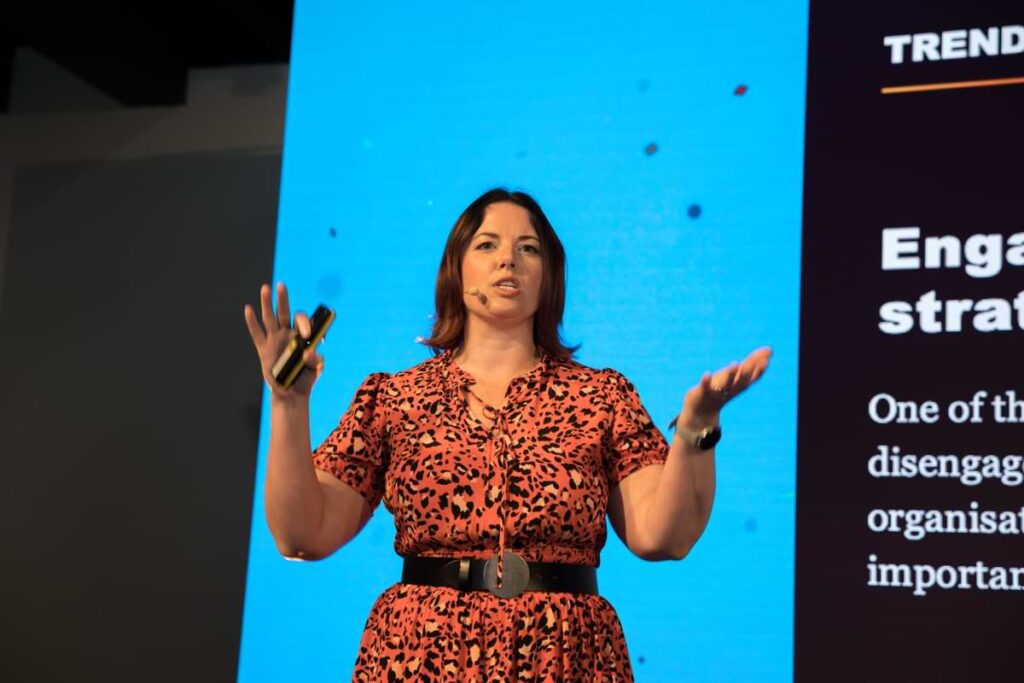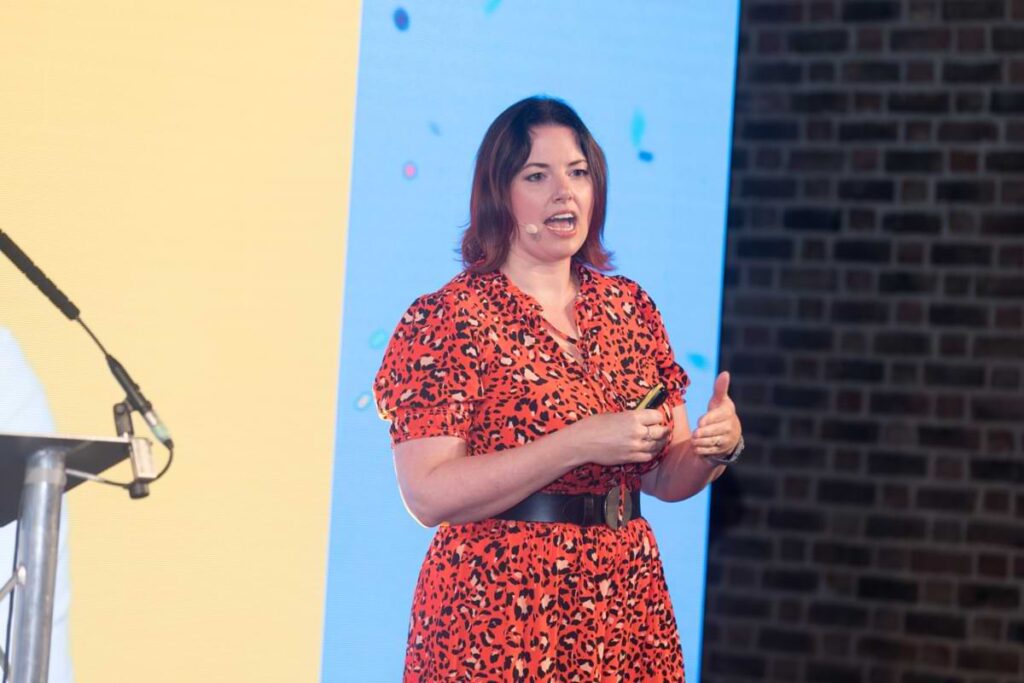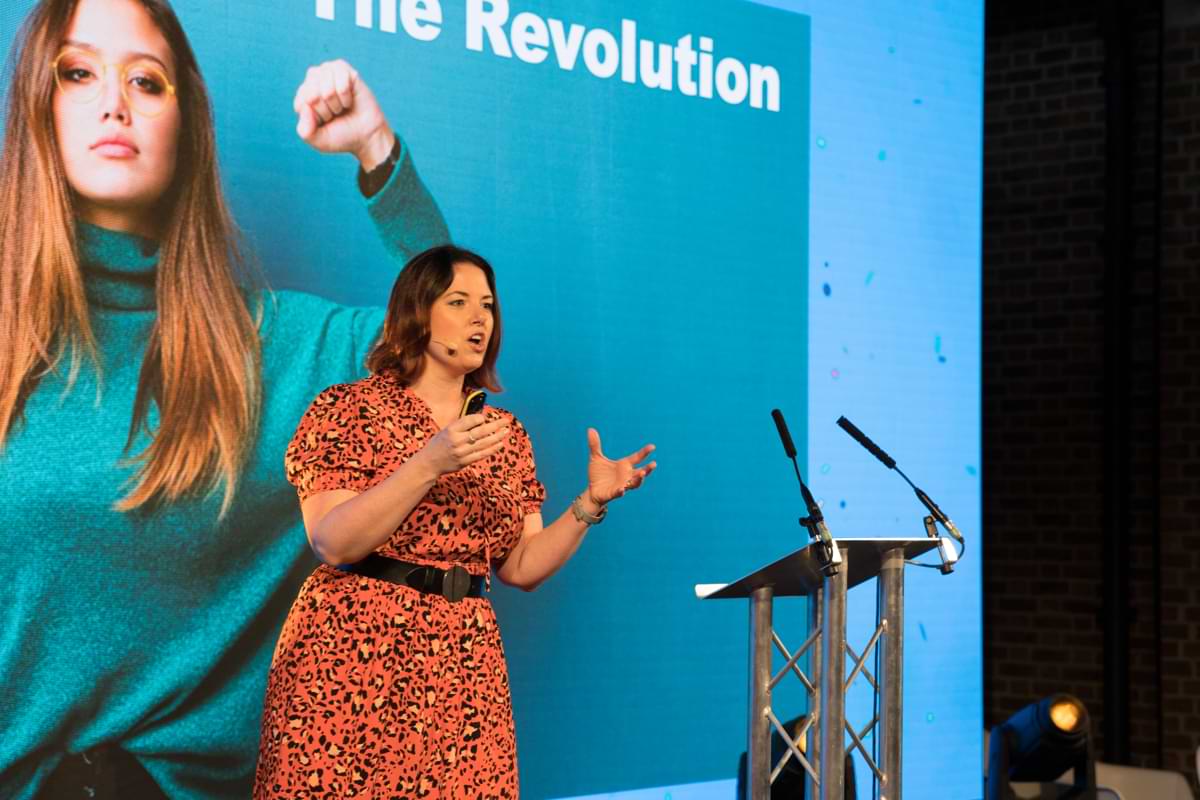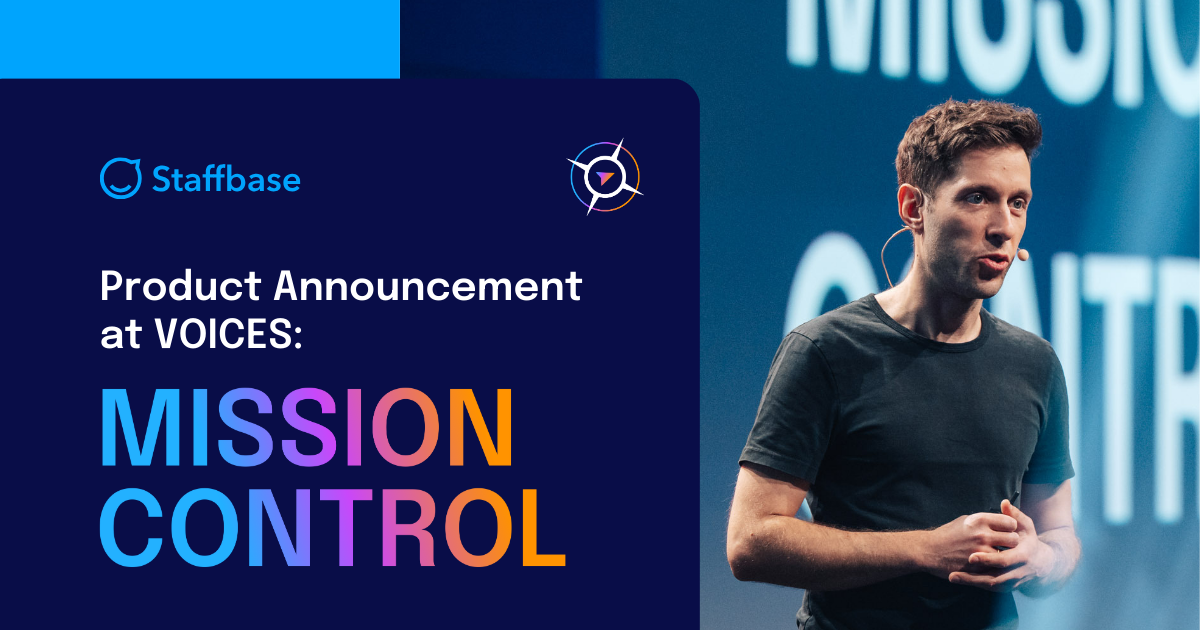With nearly 20 years of comms experience, Jenni Field has an insider's deep knowledge of the value of effective, influential internal communication and the challenges faced by its practitioners.
She is one of Inspiring Workplaces' Top 101 Global Employee Engagement and Experience Influencers, the founder and head of the consultancy Redefining Communications, and the author of Influential Internal Comms: Streamline Your Corporate Communication to Drive Efficiency and Engagement.
Jenni was the keynote speaker at VOICES London 2022, where she discussed the changing state of the comms industry and its current trends. Afterwards, she sat down to talk more about the role influential internal communication must play in times of transformation and the need for today's corporate leaders to better understand their people.

Robert Grover: Good morning. You’ve written about internal communication and chaos. Is chaos the same thing as transformation?
Jenni Field: It's a good question because it's not really. When I talk about chaos, I'm talking about toxic chaos. Chaos will happen when there are symptoms happening that are causing that chaos. If you've got people taking leaves of absence because of stress or if you've got leaders focusing on their own benefits and bonuses and things like that, those sorts of things lead to creating chaos. You have to get to the root cause of those things in order to fix them.
The transformation generally comes afterwards. You can be in chaos when you’re going through transformation, but that stems usually from a misalignment in the organization. That's where the chaos will come while you're in transformation.
RG: Would you say then that chaos is often the first hurdle of transformation?
JF: Yes, because chaos isn't just people running around and screaming and the world feeling like it's on fire. It's about the fact that there are patterns happening and you can find a way through them. That tends to happen first. If I think about when we go in and take people from chaos to calm, if they've got loads of people off on stress leave, for example, it's easy to assume why that would be.
But we would diagnose why that is. It might be that the organization isn't structured properly, there could be an issue with a manager, there could be something like that. Then you start to do the transformation, which in this case would be, we need a better leadership development program, we need to restructure whatever it might be. That's where chaos and transformation are linked together.
RG: We'll get into those steps once we start talking about The Field Model. But first, can you explain what you mean by your statement that “for Internal Communications to be truly influential, there has to be a basic understanding of people?”
JF: I talk a lot about the fact that organizations are people. Organizations are kind of a myth. They don't necessarily really exist. You can have a brand, you can have buildings and assets, but organizations are made up of people. For us to have good or influential internal communication, we have to understand people better. What's happened over the years is we haven't really progressed in our understanding of what it is to be human. Our brains haven't really evolved since we were cave people.
"For us to have good or influential internal communication, we have to understand people better."
Lots of things about us are very much the same as they've always been. We don't do well if we can't predict what's going to happen. We have to be able to keep ourselves safe. We're somewhat driven by fear. All those things exist, but leaders in organizations haven't spent the time to understand those human impulses and what it means to be a human. Therefore, we do things without understanding our impact, without truly understanding how to influence people. That's where things get difficult.
RG: Why do you think that is? Why is it so difficult for leaders to think about their employees as people?
JF: If you look at how organizations and businesses have changed over the last 40, 50 years, you’ll see that a lot of leaders in organizations have come through an educational system and a school of thought that if you need to have more boxes off the production line, you make that process more efficient and you make those people work harder or you streamline it — whatever the case might be.
We haven't adapted that logic to office-based work. Therefore, we have a lot of leaders who have this belief that, “I'll just tell you what to do and you'll do it.” We haven't adapted the skills to knowledge workers and collaboration and how work is different now with technology and the changes in society. That's why I don't think we've really adapted. I think we're still trying to use the carrot and stick approach.
Even though we know that approach doesn't work, we're still stuck using it because we don't really know what else there is to do. But I do think now that education and understanding is happening.

RG: Could you briefly describe the Field Model?
JF: Sure. The Field Model has three steps: Understand, Diagnose, and Fix. It's all about understanding the symptoms, diagnosing the root cause of those symptoms, and fixing them.
The best analogy I use is to imagine you've got a headache. You would probably take some painkillers and you would keep taking those painkillers to manage the pain. Now that's going from Understand straight to Fix, which is what we generally tend to do.
But if you took a moment and thought, "Why am I getting a headache? Is it because I need to have my eyes tested? Is it because I haven't drunk enough water today?” your treatment is no longer a painkiller, it's new glasses or more water. That's your fix because you've diagnosed the root cause. That's what we want to do in an organization.
Say we have issues between team members not getting on, for example. It's easy to think, we'll just do a workshop and get everyone working well together. But it’s better if we know why they're not getting on and then deal with that. Not just the symptom.
RG: Is one reason why people sometimes forget that middle step perhaps because Understand and Diagnose sound almost like the same thing?
JF: Yes, and that's where it does become missed because we don't ask enough questions or we're not curious enough to find out why.
It's also quite uncomfortable to have some of those conversations. If we're working with organizations that are going through mergers and acquisitions or anything like that, sometimes there are people who don't want to be part of that journey, and the symptom of that unease is that they're quite disruptive and hard for other people to work with.
We can understand that that's happening. We can diagnose that that's happening because they don't want to be on the bus, so to speak. Then the fix is that they need to leave the organization, and those sorts of things are very uncomfortable. Sometimes you can pull people back who are really disengaged. And sometimes you can't. Relationships end and that's okay.
It's easy to just blur the two together. So you have to be curious enough to ask questions and put your ego to one side. Ego is often the reason why we don't want to ask the questions. We assume, "Oh, I know why they're all stressed out. It's just because of the pandemic." But you don't really know why and we need to accept that we don't always make the right assumptions.
RG: That returns us to what you were saying about understanding people. Unless you're willing to make that effort then it's going to be quite difficult.
JF: Yes, and I think it's happening — people talk a lot about having a growth mindset. In the book, I talk about having an evolutionary mindset, and there is something around acknowledging the fact that you don't always have the answers.
Coming back to leaders and how people have been taught to lead, they haven't been taught to lead in a vulnerable way. They haven't been taught to lead by saying, "I don't know, I'll go and find out."
I have no idea where CEOs go to learn. I doubt that there's some secret club where they're all sharing knowledge. Because I think leaders believe that they still have to have all the answers.
RG: You've written that CEOs think internal communicators use employee engagement and internal communication interchangeably. If they’re not the same thing then how do they differ?
JF: They're not the same thing and they are used interchangeably and it doesn't really help us. For me, internal communication is really everything that gets said and shared inside your organization and it's about creating an engaging and efficient workplace. Employee engagement has a lot more factors to it. There's work that's been done that identified the four enablers of employee engagement, which were things like integrity and strategic narrative. Those aren’t the same as internal communication.
"For me, internal communication is really everything that gets said and shared inside your organization . . . Employee engagement has a lot more factors to it."
As an internal communicator, I can communicate inside the organization. I can create environments and spaces for people to communicate together. But I can't control whether you're engaged. There are just so many contributing factors to that and we have blurred these lines between the two. I love the phrase that employee engagement has been a great distraction for internal communications. Chuck Goss said it. And it's true. We've sort of blended the two things together and I'm not really sure how that happened.
Whereas if you look at the four enablers of employee engagement, one of them is strategic narrative. That’s the bit that internal communicators could really have on their shoulders. In my experience, an organization can have no strategic narrative and yet the impact of employee engagement is huge. But if they have a strategic narrative — whether it's good, bad, or indifferent — people do generally seem to be more engaged. Communication is a core part of employee engagement, but for me, employee engagement is the output of influential internal communication.
RG: There's a consensus who say that it's hard to measure any increases in productivity and performance that result directly from internal communication. Is this changing? How would you suggest such things are best measured?
JF: I think we have a bit of an issue with measurement generally and I think we try to measure things that we don't really need to measure. I was having a conversation with someone yesterday about their digital platform. They wanted to see who had a social reaction to something. I was like, "Why?" People just ask for random bits of data at random bits of time without any thought about how it might be helpful and what they're trying to prove.
There's a lesson for us in organizations around communication to think more about measurement. You should have a hypothesis you want to prove or disprove.
When it comes to higher productivity, that’s something you can measure because you're looking at an outcome.
CEOs have said that it's very hard to measure internal communication. That's because we spend our time asking, “Have you seen this poster? No? Okay.” That doesn't really help. Whereas if you have a poster that's tied to a campaign to reduce accidents by 60%, your measure is whether you’ve in fact reduced accidents by 60%.
Communication is one part of that. There will be other things like a redesign of the warehouse or new training, so you can't say your communication campaign has directly reduced accidents by 60%, but you can accept it as being one part of a broader initiative. I think that sometimes as internal communicators we want to try and get our hands around something and have complete ownership of it. But that's unlikely because it's just one part of a much bigger puzzle.
RG: Some digital comms tools try to make the case that interaction in the form of likes, comments, or shares are a metric for internal communication.
JF: Yes, but it comes back to what you're trying to measure. We talk to people about success measures and impact measures when it comes to digital tools and how measurement informs your action. I think that's important depending on your journey and what you're trying to measure. If you've just launched something like Staffbase, then you'll be focusing on adoption and engagement, but mainly adoption.
How are you going to measure adoption? Well, you’ll measure the number of active accounts because that's your measure and that gives you your baseline, and that's fine. That's a great measure. But if you’re trying to create behavior change to the point of fewer accidents, that's not something you can say is the sole responsibility of internal communications.
RG: My guess is that leadership is hesitant to accept that fuzzy line between a comms initiative and a specific outcome.
JF: When we did the research with CEOs, they were all quite accepting that you can't really measure internal communications. That’s lovely, but it’s not good for the measurement consultancies out there because I think organizations have gotten more mature in terms of the outcome they're trying to see, which is different from just the output.
If you are looking at things like channels and tools and getting a business case to support investing in Staffbase or anything else, then you've got to be able to demonstrate that you are having an impact.
"There are lots of different ways you can measure things, but it depends on what you're trying to do. Are you trying to create a more engaged workforce or a more efficient workforce or both? Then how do you want to measure that through success or impact?"
I’ve done work in my career where we looked at the time it took people to do things and gauged how much time was saved by introducing technology. There are lots of different ways you can measure things, but it depends on what you're trying to do. Are you trying to create a more engaged workforce or a more efficient workforce or both? Then how do you want to measure that through success or impact?
RG: As you were saying earlier, engagement can be affected by so many different things.
JF: So many things, so many things. So many things that are just so individual to you as a person and that the organization has nothing to do with at all.
RG: You write that the role of communication inside an organization is paramount to its success. But if effective communication is so difficult to quantify, how do you support this conclusion?
JF: Because it's about relationships in the workplace. It's not just about the channels and communication in that sense. It's about making sure that communication flows across the organization.
No matter what size organization you are, people have to be skilled enough in communication in order to maintain relationships that ensure the organization is efficient and engaging. What we tend to focus on is the channel to fix the problem. Whereas the role of communication is paramount because if you and I are working together and we can't communicate with each other, that's not going to make for a good working environment for either of us. Nor will it make for an efficient working environment. We have to learn our preferred styles. What's the cadence of meetings for us? How do we work with other stakeholders? That's all communication. It's not just the channels.
RG: How important is it for communicators to align their communication strategy and plans with the overall business strategy?
JF: Oh, it's a non-negotiable for me because otherwise, you're just being really noisy, which isn’t great because you can be really busy doing not a lot.
If you’re not linked to what the business is trying to do, you’re not helping the business achieve its objectives. Whenever we look at content frameworks or channel matrices, and these are all things I had when I worked inside organizations, you'd have your business objectives and then your content pillars sitting underneath them, and then your channels for reaching your various audiences. But everything hooks back into those business objectives, otherwise you’re just being really noisy.
"If your comms strategy isn't linked to what the business is trying to do, then you’re not helping the business achieve its objectives."
It was interesting in the conference today when they were sharing the statistics of the industry. It was said that most internal communicators are spending 75% of their time just broadcasting and pushing stuff out. This is exactly what I was worried about in the pandemic. Everyone got very excited that suddenly internal communicators were being given the opportunity to have conversations at a senior level and were suddenly very important. But we were important for pushing information out. We weren't suddenly an important strategic function.
I'm worried that actually we've almost gone backward. We confused this attention with progress and it’s not the same thing. If we've got 75% of internal communicators just broadcasting messages out, that's gone backward probably from before the pandemic. We have to reset that now in terms of, “I know I helped out in a crisis, but actually my function is here to do much more.”
RG: I think the speakers were trying to argue that all that time just pushing out information gets in the way of comms professionals doing their jobs effectively.
JF: Yes, it does. If I'm spending 75% of my time just pushing out information, that's a barrier to me being strategic. And if it’s true, then the belief that we’re now being seen as more strategic on the back of the pandemic is a myth. We’re thinking of the attention we’re now getting as progress.

RG: How can communicators manage the communications channel mix in their organization so that it's not overwhelming?
JF: You have to have a purpose for every channel. There has to be a very clear purpose around the content and the audience, and there has to be a review of the frequency of channels to make sure that you haven't got things going out all at the same time.
The overwhelmingness comes when things get too noisy. That might be what people feel, and it comes from information not being relevant. We know from research that we've done. If people feel overwhelmed by the number of channels or the amount of information they're getting, it's because there's just a lot of noise and the content isn't relevant. Relevance is the antidote to that.
Also, have a look at your channels. I used to review my channels and strategy every year. Because otherwise you just become stuck doing the same thing. Is it working? Does it need tweaking? We have to have that learning mindset of test and adapt and test and adapt, which our marketing colleagues are very good at, and we're not so good at it inside organizations.
I used to have a nice suite of channels. It was a long time ago, but I had a print magazine; I had some face-to-face town halls; we had an intranet that had a weekly and then daily newsletter. We had a nice mix of this is monthly, this is quarterly, this is face-to-face, this is print. That's what’s important about your channel matrix. If everything is purely digital, then we’re not using some of the core senses that we have as people. How do we integrate channels together and how do we bring forward all of the senses that we have?
RG: I would imagine the challenge there is that as things turn to more remote style working, some of those face-to-face channels, as effective as they may have been, simply aren't possible?
JF: It's interesting. I've been reading a lot about remote work in the last few years, and even organizations that have been remote the whole time talk about the fact they get people together once or twice a year. Monthly town halls probably aren't going to happen, but if you're not getting your people together twice a year, or quarterly, then I think the relationships are going to be hard.
What's interesting now is to think about the symptoms diagnosis part of the Field Model again. We’re not correlating some of the symptoms we're seeing with the root cause of being disconnected. People say to me, “I'm loving this remote work thing. I've got so much flexibility. It's amazing. I love it.” Then at the same time saying that they're really struggling to interpret the tone of voice of emails that they're getting from people inside the organization. Those two things are linked. That's because you haven't got that connection with those people and you probably do need to go in the office and build that. But we don't seem to join those dots together.
My worry going forward is that we're going to just accept some of these symptoms that are making us anxious and worried without addressing the fact that they could be solved by actually reconnecting in person with people.
RG: Well, I think that’s a good place to wrap things up since it goes back to what you've been saying throughout this conversation about treating people as people and understanding their needs.
JF: Yes, totally.
RG: Great. Well, that was a fascinating chat. Thank you so much for taking the time to share your thoughts.




